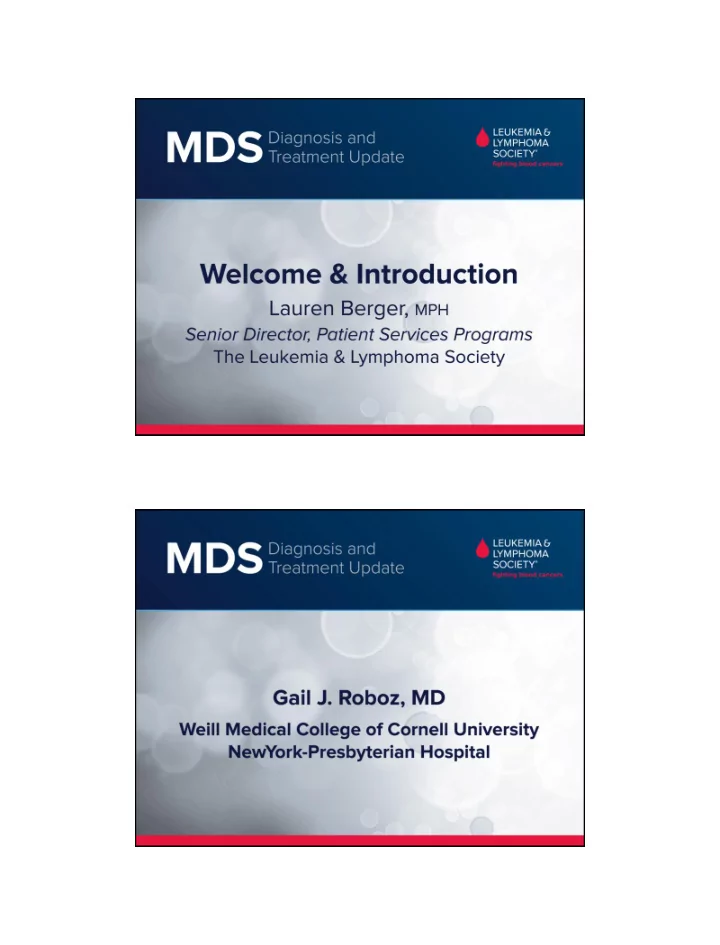

Myelodysplastic Syndrome: Let ’ s build a definition Myelo – bone marrow What is bone marrow?
What does bone marrow do? Dysplastic Dysplasia – abnormal appearance of cells when viewed under the microscope Difference shapes, sizes, granules (particles within cells) Can be caused by many medical conditions, not only MDS
Syndrome Collection of signs and symptoms associated together Myelodysplastic Syndrome Heterogeneous group of clonal hematopoietic stem cell disorders characterized by ineffective hematopoiesis, progressive pancytopenia, morphologic abnormalities and propensity to transform to AML Dysplastic hematopoiesis Impaired differentiation Accumulation of blasts Hypercellular bone marrow in ~90% Peripheral cytopenias Risk of progression to AML in 25-35% Abnormal bone marrow cytogenetics in ~50% 1. Cazzola M, Malcovati L. N Engl J Med . 2005;352:536-538 2. Heaney ML, Golde DW. N Engl J Med . 1999;340:1649-1660 3. Hofmann W-K, et al. Hematol J . 2004;5:1-8 4. MDS Foundation Resource Center. Available at: http://www.mdsresourcecenter.org/
Risk Factors Cause is unknown in >80% of patients Prior exposure to chemotherapy and/or radiation Advancing age Congenital diseases (Fanconi anemia, congenital neutropenia, rare familial MDS) ? Environmental toxins MDS Risk Factors Factor Evidence Increasing Age ++++ Male Gender ++++ Chemotherapy Agents/XRT ++++ Benzene/Solvents +++ Smoking ++ Pesticides/Herbicides/Fertilizers ++ Ionizing Radiation + Hair Dye + Slide Courtesy of S. Strom
Bone Marrow Failure: Signs and Symptoms Anemia Fatigue, pallor Shortness of breath, decreased exercise tolerance Exacerbation of heart failure, angina Neutropenia Active infection (bronchitis, sinusitis, pneumonia, etc.) Risk of infections Thrombocytopenia Petechiae, bruising, bleeding Risk of bleeding Performing a bone marrow aspiration OOOuch!!
Other diseases of bone marrow failure Hematologic conditions: congenital (hereditary sideroblastic anemia, congenital dyserythropoietic anemia, Fanconi anemia, etc.) Nutritional: deficiencies of vitamin B12, folate, iron Aplastic anemia (AA) Pure red cell aplasia Paroxysmal nocturnal hemoglobinuria (PNH) Systemic mastocytosis Hairy cell leukemia (HCL) Large granular lymphocyte disease (LGL) Myeloproliferative syndromes (idiopathic myelofibrosis, advanced polycythemia vera or essential thrombocythemia) Toxins (alcohol, medications, etc) Chronic diseases, viral infections, malignancies Required Initial Evaluation NCCN (2013) Guidelines H&P CBC with diff, platelet count, & retic Examination of peripheral blood smear BM aspirate with iron stain and cytogenetics BM biopsy Baseline serum EPO level prior to RBC transfusion RBC folate and serum B12 Serum iron/TIBC/ferritin Check thyroid function Documentation of transfusion history NCCN Practice Guidelines in Oncology: Myelodysplastic Syndrome v.2.2013
IPSS-R Prognostic Score Values Prognostic 0 0.5 1 1.5 2 3 4 variable Cytogenetics Very Good Intermediate Poor Very poor Good ≤2 5 – 10% BM Blast % >2 - <5% >10% ≥10 Hemoglobin 8 - <10 <8 ≥100 Platelets 50 - <100 <50 ≥0.8 ANC <0.8 Greenberg et al, Blood, 2012, epub ahead of print. Newer prognostic models Better age stratification (60=90??) Duration of diagnosis Prior treatments Prior transfusions Secondary disease Performance status ?? Molecular diagnostics
How is MDS treated? Supportive Care (transfusions, antibiotics, growth factors, ? iron chelation) Hypomethylating agents (azacitidine, decitabine) Immunomodulators (e.g. lenalidomide) Hematopoietic stem cell transplantation Novel Agents/Clinical trials But, before we decide “ how ” to treat, we need to know… Why are we treating???
Goals of Treatment If possible, cure me If you can ’ t cure me, at least make me live longer and feel better If you can ’ t make me live longer, at least make me feel better If you can ’ t even make me feel better, then get me another doctor and go back to school… Proposed treatment algorithm for patients with MDS Low-risk High-risk (IPSS low, INT-1) (IPSS INT-2, high) (BM blasts < 10%) (BM blasts > 10%) Any age Age ≥ 60 Age < 60 • Iron chelation • Intensive • MTI (5- • Growth factors chemotherapy AZA/decitabine) • MTI (5-AZA/decitabine) • Clinical trial (Epo + G-CSF) • MTI (5-AZA/decitabine) • Clinical trial • Intensive • Lenalidomide (5q-) chemotherapy 1 • Immunemodulation • Clinical trial 1 Consider in younger patients with diploid cytogenetics 2 Consider earlier in Failure/ younger patients Progression Atallah. Cancer Inv. 2008;26:208-16 Allo SCT
Essentials for an MDS patient: Know your risk group Know your treatment options, including whether you should be considering stem cell transplant and/or clinical trials Know what results are reasonable to expect from your treatment Know the potential side effects Know about resources (e.g. the LLS) Include your caregiver in treatment planning 21
Recommend
More recommend